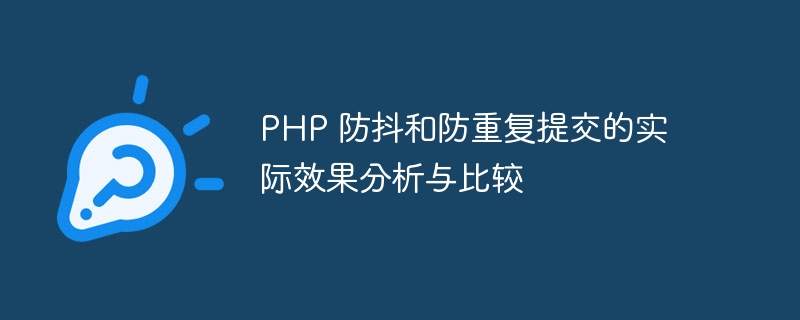Home >Backend Development >PHP Tutorial >Analysis and comparison of the actual effects of PHP anti-shake and anti-duplicate submission
Analysis and comparison of the actual effects of PHP anti-shake and anti-duplicate submission
- WBOYWBOYWBOYWBOYWBOYWBOYWBOYWBOYWBOYWBOYWBOYWBOYWBOriginal
- 2023-10-12 09:16:481358browse

PHP Analysis and comparison of the actual effects of anti-shake and anti-duplicate submission
Anti-shake and anti-duplicate submission are two common technical means in Web development. They can enable users to have a better experience during operations while also ensuring data accuracy and security. In PHP development, using appropriate anti-shake and anti-resubmit mechanisms can effectively improve the reliability and performance of the system.
1. Anti-shake mechanism
Anti-shake is a technology that avoids frequent triggering events by delaying execution. In the case where the user clicks buttons or input boxes quickly in succession, anti-shake can make the last operation effective and ignore the previous intermediate operations. This can effectively solve the problem of system resource waste and data errors caused by rapid operations.
In PHP, a simple anti-shake function can be implemented through the following code:
function debounce($func, $wait) {
$timer = null;
return function () use (&$timer, $func, $wait) {
if ($timer) {
clearTimeout($timer);
}
$timer = setTimeout($func, $wait);
};
}Usage example:
$debounceFunc = debounce(function () {
// 执行操作
}, 1000);
$debounceFunc(); // 连续点击或输入操作时,只有最后一次操作会被执行By setting the appropriate delay time, we can control the anti-shake function The effective time of dithering. If the user performs a new operation within the delay time, the previous operation will be ignored, thus reducing redundant operations.
2. Anti-duplicate submission mechanism
Anti-duplicate submission is an important means to ensure the accuracy of system data. When the user frequently clicks the submit button during the form submission process, or multiple submissions occur due to network delays, it may lead to repeated insertion or processing of data. Through a reasonable anti-duplicate submission mechanism, we can avoid this situation from happening.
In PHP, you can implement a simple anti-duplicate submission mechanism through the following code:
function isRepeatedSubmitted($key) {
return !empty($_SESSION[$key]);
}
function markAsSubmitted($key) {
$_SESSION[$key] = time();
}
function clearSubmittedMark($key) {
unset($_SESSION[$key]);
}Usage example:
session_start();
$submitKey = 'submit_key';
if (isRepeatedSubmitted($submitKey)) {
// 重复提交处理逻辑
} else {
// 正常提交处理逻辑
markAsSubmitted($submitKey);
// ...
// 其他处理操作
// ...
// 重定向到其他页面或进行其他处理
clearSubmittedMark($submitKey);
}By judging whether the corresponding $_SESSION variable exists identification, we can determine whether a duplicate submission has occurred. In order to avoid retaining the logo for a long time, the submitted logo should be cleared in time so that the next operation can proceed normally.
3. Effect Analysis and Comparison
The actual effects of the anti-shake and anti-resubmission mechanisms vary in different scenarios. Anti-shake is suitable for scenarios where users operate continuously and quickly, which can reduce unnecessary operations and improve system response speed. The anti-duplicate submission mechanism is suitable for form submission and other requirements, and can ensure the accuracy and security of data.
In actual use, it is necessary to choose the appropriate mechanism or combine the two according to the specific business scenario. Anti-shake is mainly used in the front-end user interaction process, while the anti-repeated submission mechanism is more used in the back-end data submission and processing process.
In general, anti-shake and anti-re-submission mechanisms are commonly used technical means in web development. By using them appropriately, the reliability and performance of the system can be improved. In PHP development, the corresponding anti-shake and anti-re-submission functions can be quickly realized through the above simple example code, but in practice, customized implementation still needs to be carried out according to specific business needs.
The above is the detailed content of Analysis and comparison of the actual effects of PHP anti-shake and anti-duplicate submission. For more information, please follow other related articles on the PHP Chinese website!

